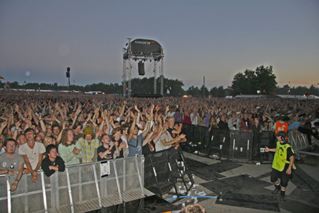 From humble beginnings in 1971, a fledging festival was taken over in 1972 by the Roskilde Foundation, which has since run the festival as a non-profit organization for development and support of music, culture, and humanism. The festival continued to grow to become one of Europe’s largest and most prestigious events today.
From humble beginnings in 1971, a fledging festival was taken over in 1972 by the Roskilde Foundation, which has since run the festival as a non-profit organization for development and support of music, culture, and humanism. The festival continued to grow to become one of Europe’s largest and most prestigious events today.
But as with many success stories it has had its low points, most notably at the 2000 festival, when nine fans died in front of the main stage in a crowd crush in muddy conditions. The accident was thoroughly investigated and documented and led to a cathartic overhaul at all levels. Since then the festival has not only continued, but flourished.
The varied programme in 2008 included The Chemical Brothers, Neil Young, Radiohead, Gnarls Barkley, Duffy, Kings of Leon, The Dillinger Escape Plan, The Streets, and The Tivoli Symphony Orchestra.
Roskilde General Manager Henrik Bondo Nielsen has worked at the festival since 1980, when he started out as a volunteer garbage collector. By 1998, he had become Festival Manager and has played a key role in introducing the many safety improvements that have taken place since 2000. Perhaps the festival’s biggest contribution to crowd safety has been the development of a barrier system which divides the audience into pens, an idea that was launched in 2001 and which has developed into today’s “four pen” design.
“After the accident in 2000 we met experts throughout Europe to discuss ways of preventing anything like that happening again.’ says Henrik. “These included The Security Company in Holland, Mojo Barriers and Stageco’s Hedwig de Meyer. With the support of the international festival community we introduced many initiatives focused on people’s experiences and well-being at our festival. We also tried hard to ensure the unique spirit of Roskilde Festival has stayed at the core of the event.”
The immediately visible changes evolving from these discussions included a new stage with video wings, giving a better visual experience and reducing the need for the audience to push for a better view. The PA was improved and the organizers divided the audience up into four separate pens, preventing large crowd surges and controlling the numbers of people in the front of stage areas.
Additionally, audiences now have to queue separately for each main stage band and leave the pens once the act has finished, carefully controlling the audience’s ingress and egress from the main live music arena. “This way, we have easy access to the audience, keep crowd density at a sensible level and each pen can be individually evacuated,” Henrik says. “A new refinement in 2008 was the inclusion of a disabled users’ platform inside the barrier. “In conjunction with the local Fire Brigade, the festival also installed a system to film the opening of the festival so that organizers could monitor the amount of people entering.
Underpinning these developments are good relations with the local authorities and emergency services, which have seen a co-ordinated approach to safety. ” Words like risk-assessment and documentation used to be rare in Denmark but now they are common practice.” says Henrik. “we’ve had a good relationship with the local authority since 2000, creating a network with all the emergency services. We have produced a Danish version of ‘The Purple Guide’, bringing organizers closer to the authorities and raising the profile of health and safety.
From 2001 onwards Mojo Barriers’ Chairman Patrick Jordan has worked closely with the organizers to develop the barrier configuration in front of the main ‘orange’ stage, creating a very safe area for fans.
Patrick explains, “There is a great health and safety culture at Roskilde. Together we have developed a configuration of barriers so that the front of stage area is split into four pens, which are emptied between the bands. The pen system means that security can control numbers in front of the stage. The crowd managers can stay very close to the audience for monitoring and recovery, while the barriers obviously break any big surges.”
Leon van der Velden was Mojo Barriers’ Project Manager. He arrived on site on the Tuesday before the event with three other Mojo Barriers crew. With the help of 20 local (volunteer) crew they installed over 1,000 meters of aluminium Mojo Barriers, including the company’s ground-breaking Barrier Load Monitor System (BLMS), which offers real-time measurements of crowd pressure.
Leon says: “There were quite a lot of special pieces due to the unusual configuration of the barrier system employed at Roskilde, so it was essential that we were well organized at both ends – in term of loading the equipment in De Meern, Holland, and then through the sequence for building, although we’d allowed plenty of time to construct this unique system and get it tested and wired up with the BLMS. Initial readings on-site showed no alarming crowd pressure peaks. W checked the barriers every morning for any movement but they were fine through-out the festival.”
As well as the barriers, Mojo Barriers supplied their proprietary Line Up Gate system enabling Roskilde to operate its unique entry system for festival fans. The Mojo Line Up Gates control the flow rate into all the pens and give the security staff an effective monitoring system.
Steen Bechmann, Hed of Security and Health and Safety at Roskilde explains how the system has been developed in 2008. “Every year we make changes,” he explains. “This year we have added Mojo Barriers Line Up Gates to control the ingress. We had up to 230 volunteers looking after the gates and the front of stage area. All our security staff have taken a six-lesson course to make sure they are competent and can treat the audience to the Roskilde experience. They learn the site layout, emergency procedures and the support procedures that we put in place.
“For our Health and Safety workers, the focus is on them and the audience ‘Looking after each other’. So they are integrated into the audience and will encourage fans to be aware of each other’s health. Health and safety is a stand alone department of the festival, running medical systems and emergency teams.”
Paul Jensen, Site Technical Manager, explains: “On the stages, production hardware has helped make the festival safer and more spectacular over the years. The introduction of screens and delays several years ago meant there was less pressure to get to the front to enjoy the experience. The latest innovation in 2008 has been to replace the 15-year-old Turbosound Aspect with JBL Vertech line array. While the principle motive for this has undoubtedly been aesthetic, the system’s renowned ability to focus sound ensures both that sound levels can be better controlled (and, as such, less likely to damage hearing) while ensuring that people at the back get as high a sound quality as those in the front.”
“It’s like 1968 again,” says Henrik Rasmussen, Managing Director of Roskilde. “Look after yourself and each other! Roskilde has always enjoyed a good proportion of international visitors (in some years making up 50% of the 80,000 strong crowd). I think this is because we place our audience at the centre of what we’re doing, from the moment they arrive on the camp sites the Sunday before the festival starts, through to getting a great line up and creating an overall great festival experience – we call it the orange experience!’
